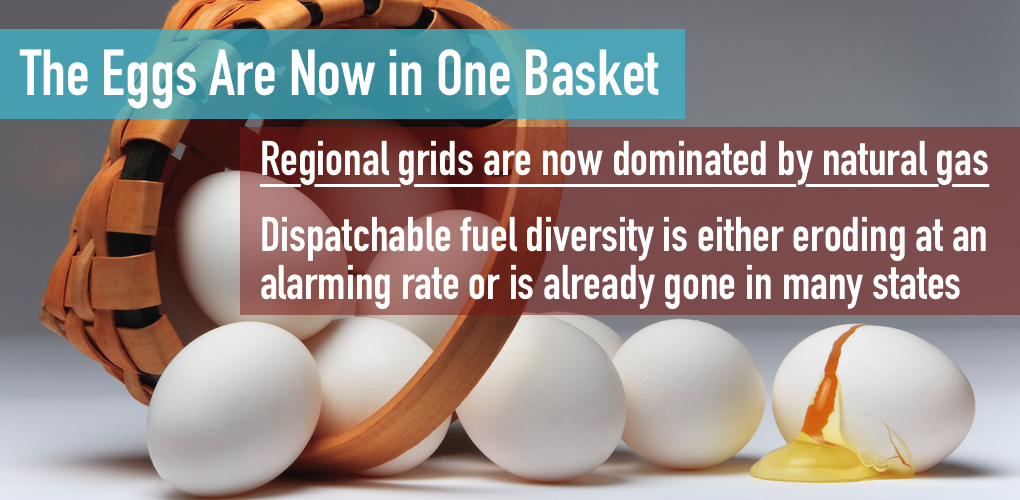
Investors First, Ratepayers Second
New natural gas power plants are being added to the electricity grid at a remarkable speed and scale. And while it’s been fashionable to believe the overwhelming impetus for this building spree has been cheap natural gas that could potentially save consumers money, while also reducing emissions, that line of thinking now has nearly as many holes as DC roads.
Fuel switching has hardly proven a silver bullet in reducing emissions. The growth in natural gas generation has far outpaced reductions in coal generation in the U.S. or new additions of renewables. In fact, a new study from the Global Carbon Project has found that natural gas is now the primary driver of emissions growth worldwide.
Utilities and the natural gas industry have marketed their effort as building a bridge to renewables. But they’re building a 14-lane monstrosity when a walking path is what renewable boosters tell us they need.
Since 2008, utilities have added more than 120 GW of new gas generating capacity. Another 200 plants totaling 70 GW of additional capacity are in the pipeline. That’s new capacity nearly equal to every existing plant on the Texas grid.
While there’s potential for growth in U.S. electricity demand driven by electrification, demand is currently flat and has been for years. What then is driving the great gas build out?
A Perverse Incentive
A new series from S&P Global Market Intelligence, titled “Overpowered,” offers up some answers. As the reporters discovered, the push for gas has far more to do with returns for investors than it does with market need or environmental altruism.
They concluded, “Cheap natural gas, though, is not the only factor driving this construction spree. Many U.S. utilities’ business models reward them for building new infrastructure, whether it’s economically viable, or truly essential, or not.”
In other words, utilities in both regulated and unregulated markets are chasing returns for investors that come from building new capacity even if the market demand for it doesn’t exist. In some cases, they’re actually repeatedly overestimating future electricity demand to push new gas investments through public service commissions, making a case for a need that never materializes.
In regulated markets, new investments are returned to the utility with a profit through the rates paid by ratepayers. Consequently, utilities have an incentive to turn hostile to their own well-operating assets to chase the guaranteed return of building new, whether or not electricity demand warrants it.
S&P used Virginia and Dominion Energy to illustrate the point. “Like many regulated utilities, Dominion makes money not only by selling electricity, but also by building new plants… Virginia remains vertically integrated, allowing Dominion to be paid in full for new capacity, including an approved profit. For a plant that costs $1 billion to build, for example, customers could pay up to $3.5 billion over the facility’s 40-year life after financing costs and utility returns are included.”
That’s a return that’s guaranteed whether or not the plant is needed, whether it ever operates profitably or even if it closes early. This is a model that’s proving deeply lucrative for investors even if it’s imposing unneeded costs on ratepayers.
It’s no coincidence that the U.S. Energy Information Administration recently reported that the number of utilities filing rate cases, the vehicle regulated utilities use to change rates with public service commissions, is now at its highest number since 1983. Of the 89 utilities filing rate cases last year, 78 proposed rate increases.
The Eggs Are Now in One Basket
Regional grids are now dominated by natural gas. Dispatchable fuel diversity is either eroding at an alarming rate or is already gone in many states. Ratepayers have been forced to pay for new generation the grid doesn’t need while undoing the fuel optionality that has long proven a strength of the U.S. electricity system.
While gas prices currently remain low, the ever-expanding demand for U.S. natural gas – whether from new U.S. gas power plants, U.S. manufacturing or exports – along with reduced appetite from Wall Street to bankroll shale producers may usher in a new era of volatile natural gas prices. With dispatchable fuel diversity gone or going – 40 percent of the coal fleet has closed since 2010 – that volatility will fall directly on the shoulders of U.S. consumers.
Instead of pushing expensive mandates or chasing the best deals for investors, isn’t it past time to put ratepayers first? Public service commissions need to recognize and reject the unnecessary and costly obsession to build new. Competitive markets, and their architects, need to better value fuel security and diversity. Affordable, reliable coal capacity is an essential part of a balanced, reliable and resilient electricity mix.
- On December 13, 2019
